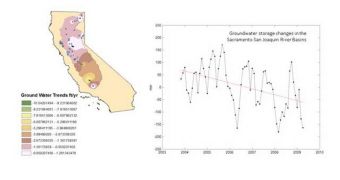According to experts at the American space agency, the main aquifers in California, and the Sierra Nevada mountains have lost enough freshwater since 2003 to fill Lake Mead, which is the largest water reservoir in the United States. The study also reveals that, unless steps to mitigate these phenomena are taken quickly, agriculture and cities may become very thirsty very soon. The new assessments are based on data collected over the past six years by the NASA/German Aerospace Center Gravity Recovery and Climate Experiment (Grace).
Losing aquifer water is very dangerous, experts warn, particularly because these underground water reserves fuel California's primary agricultural region, the Central Valley. The main source of replenishment for these aquifers are waters coming in from the Sierra Nevada mountains, which also exhibit reduced flows, and a lower ability to refill what is being consumed. The new findings are in tune with previous work, which showed that California was abusing its water reserves, pumping very large amounts of the liquid for human uses such as irrigation, while neglecting the replenishment process.
“Grace data reveal groundwater in these basins is being pumped for irrigation at rates that are not sustainable if current trends continue. This is leading to declining water tables, water shortages, decreasing crop sizes and continued land subsidence. The findings have major implications for the US economy, as California's Central Valley is home to one sixth of all U.S. irrigated land, and the state leads the nation in agricultural production and exports,” University of California in Irvine (UCI) Professor Jay Famiglietti says. Since 2003, he adds, the Sacramento and San Joaquin drainage basins have lost more than 30 cubic kilometers of water, or 30 times 264.2 billion gallons.
“By providing data on large-scale groundwater depletion rates, Grace can help California water managers make informed decisions about allocating water resources,” Grace project scientist Michael Watkins explains. The mission is handled for NASA's Science Mission Directorate, in Washington DC, by the Jet Propulsion Laboratory (JPL), a facility managed by the California Institute of Technology (Caltech).
“California and India are just two of many regions around the world where Grace data are being used to study droughts, which can have devastating impacts on societies and cost the U.S. economy $6 to $8 billion annually,” hydrologist Matt Rodell, from the NASA Goddard Space Flight Center, in Greenbelt, Maryland, shares. NASA is working with the National Oceanic and Atmospheric Administration and the University of Nebraska-Lincoln to incorporate Grace data into NOAA's US and North American Drought Monitors, premier tools used to minimize drought impacts.

 14 DAY TRIAL //
14 DAY TRIAL //